 中3英語
中3英語
 中3英語
中3英語
【英語】私立一貫校向け英語教材Lesson4-2 Stage3の英文解説
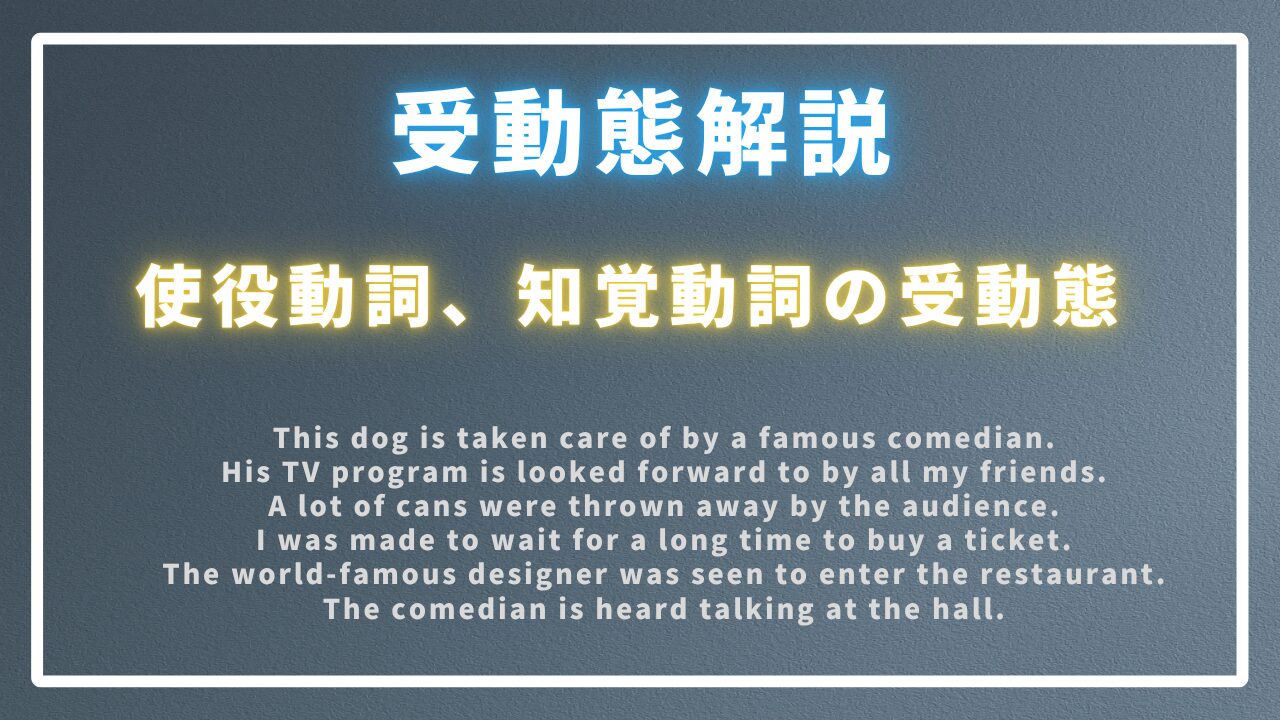
単元:
#英語(中学生)#英語(高校生)#英文法#中3英語#受動態#受動態
教材:
#NT ENGLISH SERIES#中高教材#Third Edition Stage3#Lesson3
指導講師:
理数個別チャンネル
問題文全文(内容文):
This dog is taken care of by a famous comedian.
His TV program is looked forward to by all my friends.
A lot of cans were thrown away by the audience.
I was made to wait for a long time to buy a ticket.
The world-famous designer was seen to enter the restaurant.
The comedian is heard talking at the hall.
この動画を見る
This dog is taken care of by a famous comedian.
His TV program is looked forward to by all my friends.
A lot of cans were thrown away by the audience.
I was made to wait for a long time to buy a ticket.
The world-famous designer was seen to enter the restaurant.
The comedian is heard talking at the hall.
【英語】私立一貫校向け英語教材Lesson4-1 Stage3の英文解説
単元:
#英語(中学生)#英語(高校生)#英文法#中3英語#受動態#受動態
教材:
#NT ENGLISH SERIES#中高教材#Third Edition Stage3#Lesson4
指導講師:
理数個別チャンネル
問題文全文(内容文):
The professor's book will be published next year.
The file should be downloaded before the lecture starts.
Her new book is being advertised in the newspapers now.
Many comments about the book have been posted on the website.
この動画を見る
The professor's book will be published next year.
The file should be downloaded before the lecture starts.
Her new book is being advertised in the newspapers now.
Many comments about the book have been posted on the website.
【英語】私立一貫校向け英語教材Lesson3-4 Stage3の英文解説
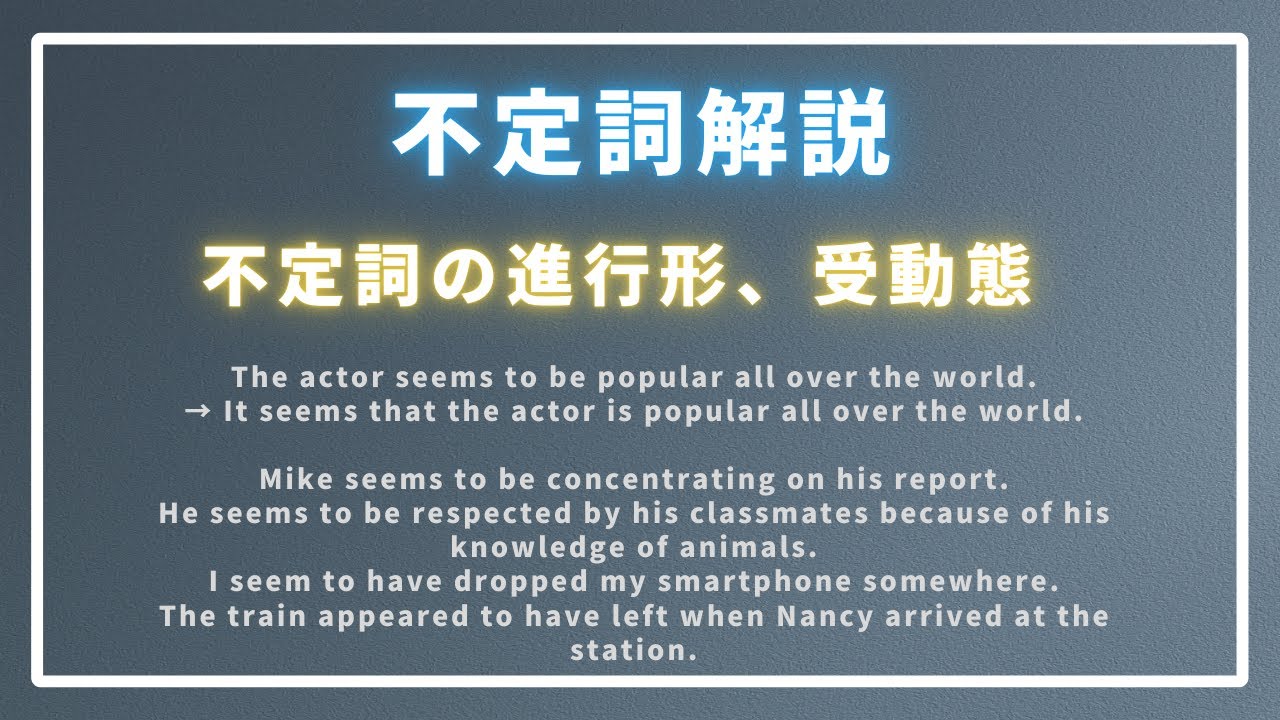
単元:
#英語(中学生)#英語(高校生)#英文法#中3英語#不定詞#不定詞(疑問詞+to,It~for to,ask(tell,want)O to,too~to,enough~to,not to)
教材:
#NT ENGLISH SERIES#中高教材#Third Edition Stage3#Lesson3
指導講師:
理数個別チャンネル
問題文全文(内容文):
The actor seems to be popular all over the world.
→ It seems that the actor is popular all over the world.
Mike seems to be concentrating on his report.
He seems to be respected by his classmates because of his knowledge of animals.
I seem to have dropped my smartphone somewhere.
The train appeared to have left when Nancy arrived at the station.
この動画を見る
The actor seems to be popular all over the world.
→ It seems that the actor is popular all over the world.
Mike seems to be concentrating on his report.
He seems to be respected by his classmates because of his knowledge of animals.
I seem to have dropped my smartphone somewhere.
The train appeared to have left when Nancy arrived at the station.
【英語】私立一貫校向け英語教材Lesson3-3 Stage3の英文解説
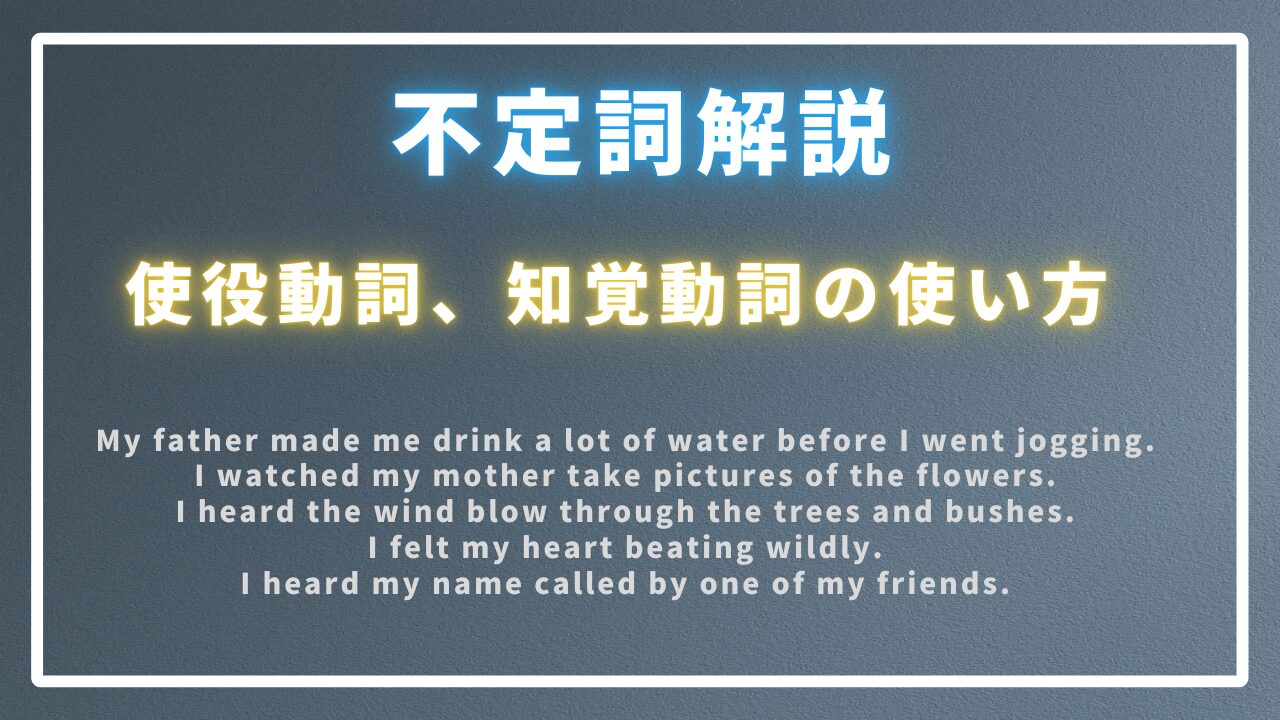
単元:
#英語(中学生)#英語(高校生)#英文法#中3英語#不定詞#不定詞(疑問詞+to,It~for to,ask(tell,want)O to,too~to,enough~to,not to)
教材:
#NT ENGLISH SERIES#中高教材#Third Edition Stage3#Lesson3
指導講師:
理数個別チャンネル
問題文全文(内容文):
My father made me drink a lot of water before I went jogging.
I watched my mother take pictures of the flowers.
I heard the wind blow through the trees and bushes.
I felt my heart beating wildly.
I heard my name called by one of my friends.
この動画を見る
My father made me drink a lot of water before I went jogging.
I watched my mother take pictures of the flowers.
I heard the wind blow through the trees and bushes.
I felt my heart beating wildly.
I heard my name called by one of my friends.
【英語】私立一貫校向け英語教材Lesson3-2 Stage3の英文解説

単元:
#英語(中学生)#英語(高校生)#英文法#中3英語#不定詞#不定詞(疑問詞+to,It~for to,ask(tell,want)O to,too~to,enough~to,not to)
教材:
#NT ENGLISH SERIES#中高教材#Third Edition Stage3#Lesson3
指導講師:
理数個別チャンネル
問題文全文(内容文):
Would you give me something hot to drink?
We walked along the river and looked for a bench to sit on.
Can you lend me something to write with?
We looked for a bench to sit on.
Michael came to realize the importance of teamwork.
He got to know the members of the team very well.
George seems to like the latest novel by the writer.
この動画を見る
Would you give me something hot to drink?
We walked along the river and looked for a bench to sit on.
Can you lend me something to write with?
We looked for a bench to sit on.
Michael came to realize the importance of teamwork.
He got to know the members of the team very well.
George seems to like the latest novel by the writer.
【英語】私立一貫校向け英語教材Lesson3-1 Stage3の英文解説
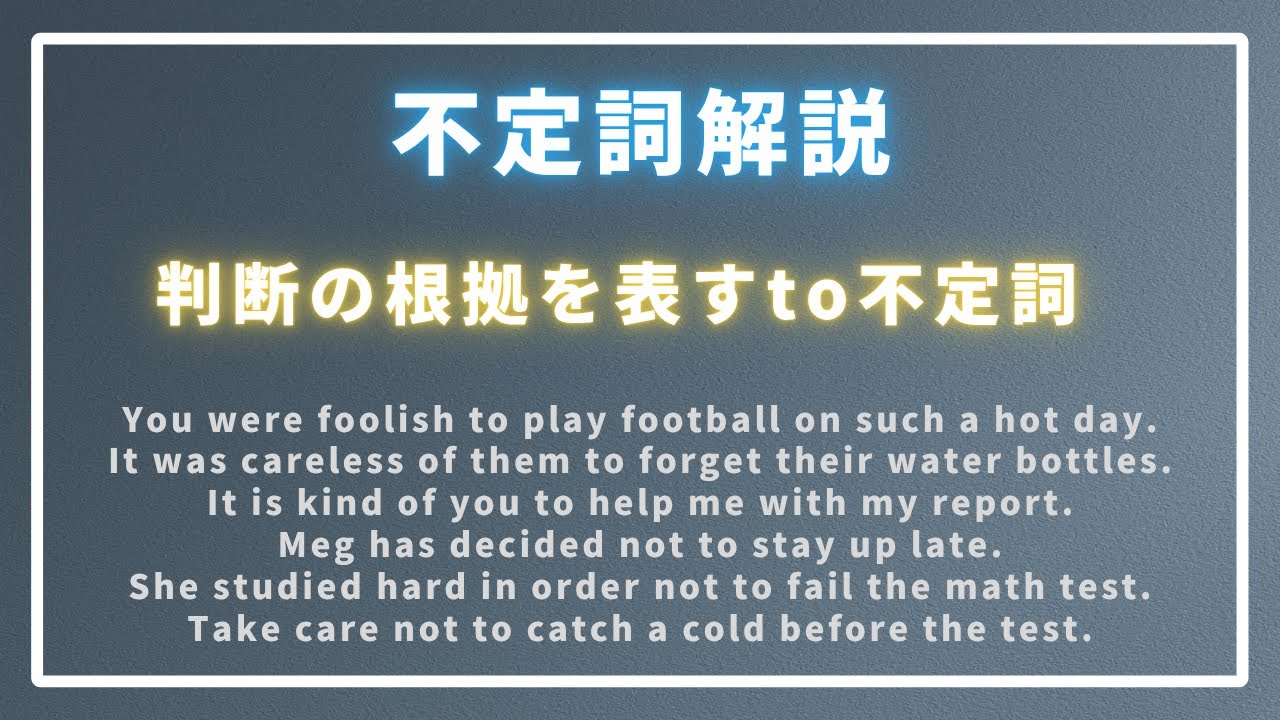
単元:
#英語(中学生)#英語(高校生)#英文法#中3英語#不定詞#不定詞(疑問詞+to,It~for to,ask(tell,want)O to,too~to,enough~to,not to)
教材:
#NT ENGLISH SERIES#中高教材#Third Edition Stage3#Lesson3
指導講師:
理数個別チャンネル
問題文全文(内容文):
You were foolish to play football on such a hot day.
It was careless of them to forget their water bottles.
It is kind of you to help me with my report.
Meg has decided not to stay up late.
She studied hard in order not to fail the math test.
Take care not to catch a cold before the test.
この動画を見る
You were foolish to play football on such a hot day.
It was careless of them to forget their water bottles.
It is kind of you to help me with my report.
Meg has decided not to stay up late.
She studied hard in order not to fail the math test.
Take care not to catch a cold before the test.
ヒプマイで学ぶ英語の格言とことわざ5 #shorts

単元:
#英語(中学生)#英語(高校生)#中1英語#中2英語#中3英語#高校入試過去問(英語)
指導講師:
Morite2 English Channel
問題文全文(内容文):
え、知ってた?『ヒプマイ』で学ぶ英語の格言が、実はめちゃくちゃ実用的!🔑
「You can't make an om without breaking eggs(卵を割らないとオムレツは作れない)」は、「犠牲が必要」という意味で、なんと入試問題で問われたりする重要フレーズ。ただ、なんだか古い感じがするらしい。
一方、**「Tomorrow is another day(明日は明日の風が吹く)」**は、友達への応援やグリーティングカードにも使える、めちゃくちゃ便利な定番フレーズ。第1シーズンの終わり方もこれで、すごく綺麗だと評価されてるぞ!
ちなみに、日本に長く住んでいると、ある一定の段階に達したら花粉症を発症する可能性が高いらしい... 怖すぎ! 海外勢はマジで要注意だ。
この動画を見る
え、知ってた?『ヒプマイ』で学ぶ英語の格言が、実はめちゃくちゃ実用的!🔑
「You can't make an om without breaking eggs(卵を割らないとオムレツは作れない)」は、「犠牲が必要」という意味で、なんと入試問題で問われたりする重要フレーズ。ただ、なんだか古い感じがするらしい。
一方、**「Tomorrow is another day(明日は明日の風が吹く)」**は、友達への応援やグリーティングカードにも使える、めちゃくちゃ便利な定番フレーズ。第1シーズンの終わり方もこれで、すごく綺麗だと評価されてるぞ!
ちなみに、日本に長く住んでいると、ある一定の段階に達したら花粉症を発症する可能性が高いらしい... 怖すぎ! 海外勢はマジで要注意だ。
ヒプマイで学ぶ英語の格言とことわざ1 #shorts
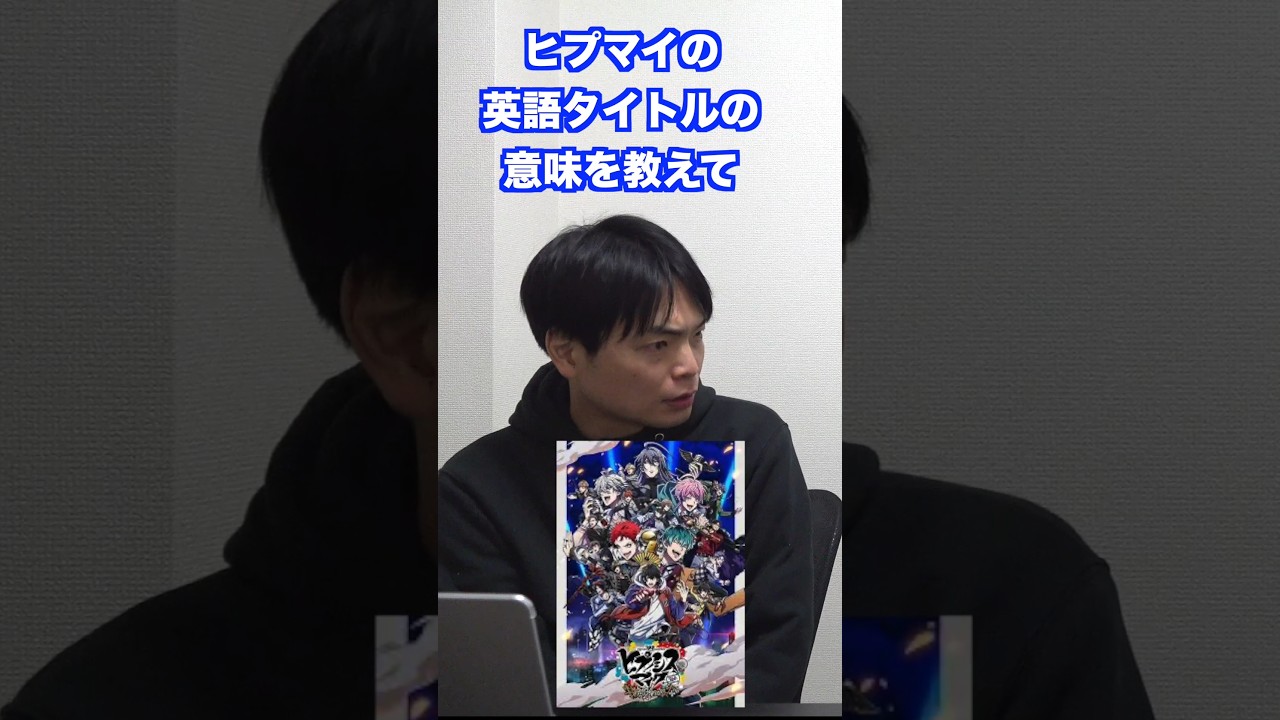
単元:
#英語(中学生)#英語(高校生)#会話文・イディオム・構文・英単語#中1英語#中2英語#中3英語#アルファベットと単語#英単語#英語リスニング・スピーキング#高校入試過去問(英語)#リスニング
指導講師:
Morite2 English Channel
問題文全文(内容文):
ヒプマイで英語の格言をマスター!モリテツとチカさんが、アニメの激アツなタイトルに隠された深すぎる意味を解説するショート動画が公開だ。
全アニメタイトルが英語の格言やことわざになっているというヒプマイ。第1話のタイトルは「As a man is born, he DIE」。これ、「人は生まれた瞬間から死に始めている」っていう哲学すぎるメッセージを込めているぞ。人生の儚さを表しており、哲学的な考え方として知られているらしい。
さらに、超有名ことわざ「噂をすれば影が差す」の英語表現、「Speak of the Devil and he will appear」を紹介。実はネイティブは「and he will appear」はあんまり言わず、「Speak of the Devil」だけで十分通じるっていう裏技まで暴露されている!
猫耳のチカさんが登場するこの動画、ヒプマイファンも英語学習者も必見の神回だ。
この動画を見る
ヒプマイで英語の格言をマスター!モリテツとチカさんが、アニメの激アツなタイトルに隠された深すぎる意味を解説するショート動画が公開だ。
全アニメタイトルが英語の格言やことわざになっているというヒプマイ。第1話のタイトルは「As a man is born, he DIE」。これ、「人は生まれた瞬間から死に始めている」っていう哲学すぎるメッセージを込めているぞ。人生の儚さを表しており、哲学的な考え方として知られているらしい。
さらに、超有名ことわざ「噂をすれば影が差す」の英語表現、「Speak of the Devil and he will appear」を紹介。実はネイティブは「and he will appear」はあんまり言わず、「Speak of the Devil」だけで十分通じるっていう裏技まで暴露されている!
猫耳のチカさんが登場するこの動画、ヒプマイファンも英語学習者も必見の神回だ。
藤川天がトマホークのチャンネルに登場【実はこうだった】

単元:
#英語(中学生)#英語(高校生)#中1英語#中2英語#中3英語#英語リスニング・スピーキング#高校入試過去問(英語)#大学入試解答速報#英語
指導講師:
Morite2 English Channel
問題文全文(内容文):
藤川天がトマホークのチャンネルについに登場した動画の裏話が激アツ公開!
共演予定だった**ベテランチがまさかのドタキャン**(体調不良)というハプニングが発生。トマホークは、石丸慎二の再生数を藤川天に超えてもらい、来なかったベテランチに後悔させたいと思っているらしい。
この動画は、日大の合否発表当日に撮影された。裏側では、てんちゃんが**「一人じゃ怖い」**と言い、松原さんに同行を熱望していたことが判明している。
動画内では、藤川天の衝撃の経歴やスペックが次々と明らかになったぞ。共通テスト3割、全国模試で下から2番。そして、なんと**英検3級に3度も不合格**。他にも、父が残した借金が0.5億円(5000万円)という話も出ている。
実は撮影時間は90分にも及び、トマホークはてんちゃんとベテランチの遅刻や欠席を予想して場所を6時間も確保していたという。てんちゃんは無言の時間(間)がとても多く、編集でかなり縮められているとのこと。さらに、撮影場所が寒かったため、モリテツ氏もてんちゃんも**ズボンの下に手を入れていた**という秘密も暴露された。
そして何より、まだ「本気授業」など、**衝撃的な内容のお蔵入り動画が大量にストックされている**らしい。受験が終われば、続々と公開される可能性があるため、今後の展開に注目だ!
この動画を見る
藤川天がトマホークのチャンネルについに登場した動画の裏話が激アツ公開!
共演予定だった**ベテランチがまさかのドタキャン**(体調不良)というハプニングが発生。トマホークは、石丸慎二の再生数を藤川天に超えてもらい、来なかったベテランチに後悔させたいと思っているらしい。
この動画は、日大の合否発表当日に撮影された。裏側では、てんちゃんが**「一人じゃ怖い」**と言い、松原さんに同行を熱望していたことが判明している。
動画内では、藤川天の衝撃の経歴やスペックが次々と明らかになったぞ。共通テスト3割、全国模試で下から2番。そして、なんと**英検3級に3度も不合格**。他にも、父が残した借金が0.5億円(5000万円)という話も出ている。
実は撮影時間は90分にも及び、トマホークはてんちゃんとベテランチの遅刻や欠席を予想して場所を6時間も確保していたという。てんちゃんは無言の時間(間)がとても多く、編集でかなり縮められているとのこと。さらに、撮影場所が寒かったため、モリテツ氏もてんちゃんも**ズボンの下に手を入れていた**という秘密も暴露された。
そして何より、まだ「本気授業」など、**衝撃的な内容のお蔵入り動画が大量にストックされている**らしい。受験が終われば、続々と公開される可能性があるため、今後の展開に注目だ!
藤川天が高橋優の「あいのうた」を熱唱 #shorts
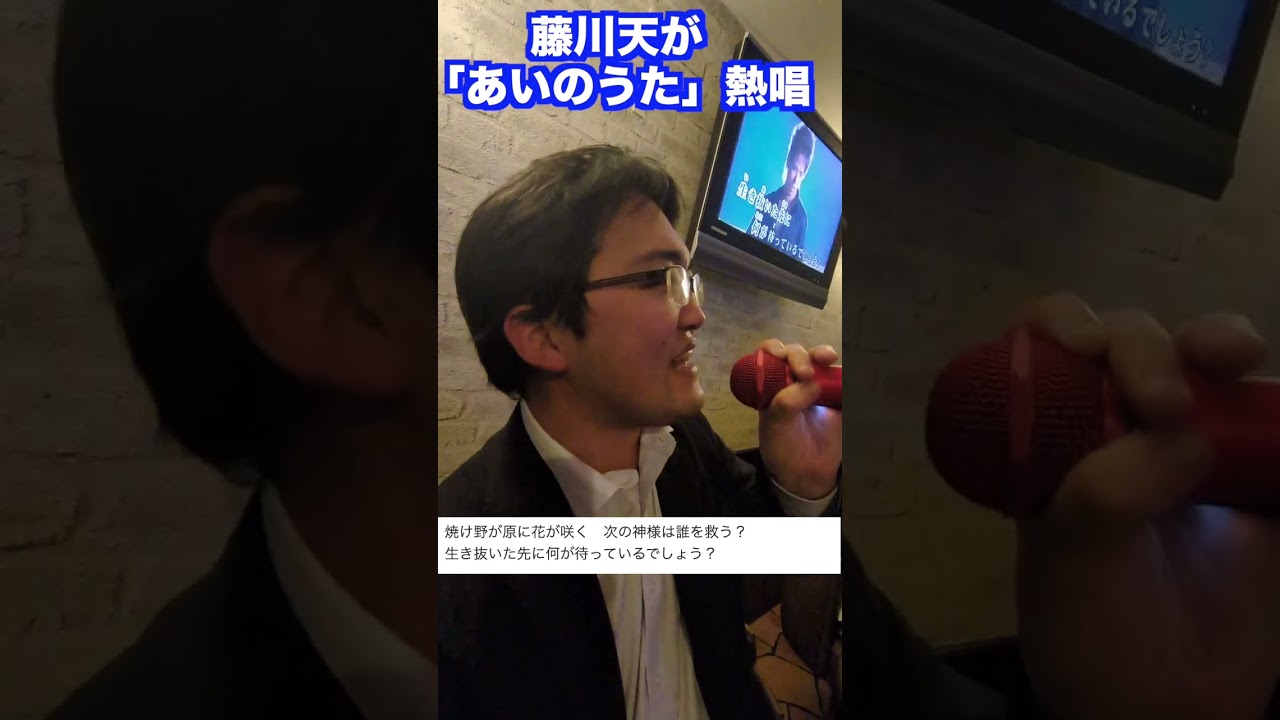
単元:
#英語(中学生)#英語(高校生)#中1英語#中2英語#中3英語#英語リスニング・スピーキング#高校入試過去問(英語)
指導講師:
Morite2 English Channel
問題文全文(内容文):
藤川天が、高橋優の「あいのうた」を激アツ熱唱!このショート動画、歌詞が深すぎる。
「平和の歌が聞こえる」という状況にも関わらず、あえて「イヤホンで聞こえないようにしてる」という皮肉なフレーズからスタート。さらに、「笑おうといいながら誰かを」といった、心に突き刺さるようなメッセージが展開されるぞ。
情熱的に「愛したいさ」と歌い上げた直後に、まさかの「歌は向いてないな」という衝撃のセリフで締めくくられる展開は必見!この魂の叫びと自虐のギャップが癖になる歌唱動画を今すぐチェックだ。
この動画を見る
藤川天が、高橋優の「あいのうた」を激アツ熱唱!このショート動画、歌詞が深すぎる。
「平和の歌が聞こえる」という状況にも関わらず、あえて「イヤホンで聞こえないようにしてる」という皮肉なフレーズからスタート。さらに、「笑おうといいながら誰かを」といった、心に突き刺さるようなメッセージが展開されるぞ。
情熱的に「愛したいさ」と歌い上げた直後に、まさかの「歌は向いてないな」という衝撃のセリフで締めくくられる展開は必見!この魂の叫びと自虐のギャップが癖になる歌唱動画を今すぐチェックだ。
bigとlargeの違いは?

単元:
#英語(中学生)#英語(高校生)#英文解釈#中1英語#中2英語#中3英語#英単語#高校入試過去問(英語)
指導講師:
Morite2 English Channel
問題文全文(内容文):
bigとlargeの違い、、、??
この動画を見る
bigとlargeの違い、、、??
【大激怒】もりてつが勝手に塾の広告に使用されていた

単元:
#英語(中学生)#英語(高校生)#英検・TOEIC・IELTS・TOEFL・IELTS等#英検#中1英語#中2英語#中3英語#高校入試過去問(英語)
指導講師:
Morite2 English Channel
問題文全文(内容文):
もりてつが勝手に塾の広告に使用されていた?!
この動画を見る
もりてつが勝手に塾の広告に使用されていた?!
Lesson4-1, 4-2 NT Stage3 3rd Edition【教えて鈴木先生!がていねいに解説】
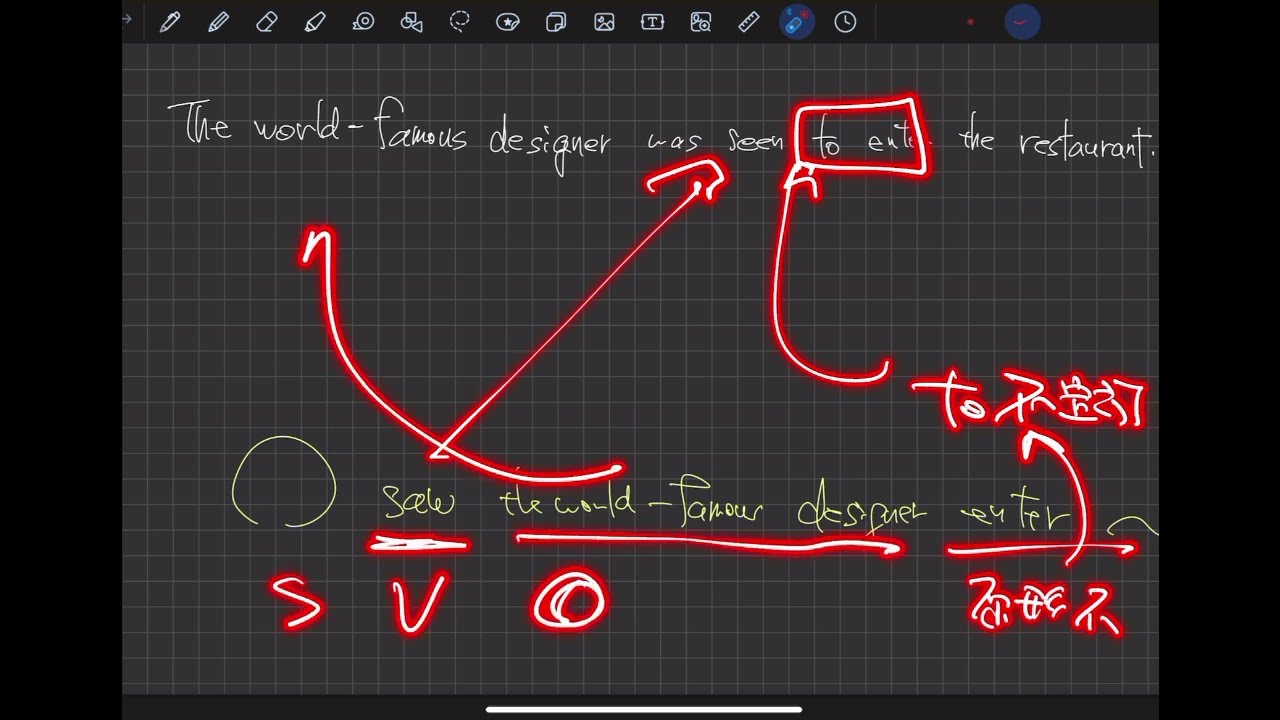
単元:
#英語(中学生)#英語(高校生)#英文法#中3英語#受動態#受動態
教材:
#NT ENGLISH SERIES#中高教材#Third Edition Stage3#Lesson4
指導講師:
理数個別チャンネル「文系館」
問題文全文(内容文):
下記の文法を含む例文を解説しています。
・助動詞を含む受動態
・進行形、完了形の受動態
・句動詞の受動態
・使役動詞、知覚動詞の受動態
この動画を見る
下記の文法を含む例文を解説しています。
・助動詞を含む受動態
・進行形、完了形の受動態
・句動詞の受動態
・使役動詞、知覚動詞の受動態
オススメの海外英語系YouTuber

単元:
#英語(中学生)#中1英語#中2英語#中3英語#英語リスニング・スピーキング#高校入試過去問(英語)#リスニング#英語
指導講師:
Morite2 English Channel
問題文全文(内容文):
この動画が提起する主要な問題点は、英語学習者が楽しく効果的に学べる海外のYouTubeチャンネルを見つけることの難しさです。
・特に、イギリス英語またはアメリカ英語のどちらを学びたいかによって、適切な学習リソースの選択に迷うことがあります。
・また、初心者から中級者まで、レベルに合わせた分かりやすい説明と綺麗な発音**を提供する信頼できるYouTuberの需要が高いです。
・この動画は、そのような学習者のニーズに応えるため、「英語学習が楽しくなる海外YouTuberを教えてほしい」という具体的な疑問に答える形で情報を提供しています。
・したがって、動画の目的は、学習者が自分に合った質の高い英語学習チャンネルを効率的に見つける手助けをすることにあります。
・紹介されているルーシーとレイチェルのチャンネルは、この「見つけにくい」という問題を解決するための具体的な選択肢として提示されています。
この動画を見る
この動画が提起する主要な問題点は、英語学習者が楽しく効果的に学べる海外のYouTubeチャンネルを見つけることの難しさです。
・特に、イギリス英語またはアメリカ英語のどちらを学びたいかによって、適切な学習リソースの選択に迷うことがあります。
・また、初心者から中級者まで、レベルに合わせた分かりやすい説明と綺麗な発音**を提供する信頼できるYouTuberの需要が高いです。
・この動画は、そのような学習者のニーズに応えるため、「英語学習が楽しくなる海外YouTuberを教えてほしい」という具体的な疑問に答える形で情報を提供しています。
・したがって、動画の目的は、学習者が自分に合った質の高い英語学習チャンネルを効率的に見つける手助けをすることにあります。
・紹介されているルーシーとレイチェルのチャンネルは、この「見つけにくい」という問題を解決するための具体的な選択肢として提示されています。
日本で間違いと習うto not doをネイティブは使うの?

単元:
#英語(中学生)#英語(高校生)#英文法#中3英語#不定詞#不定詞(疑問詞+to,It~for to,ask(tell,want)O to,too~to,enough~to,not to)#英語リスニング・スピーキング
指導講師:
Morite2 English Channel
問題文全文(内容文):
【衝撃】学校で「間違い」と習うあの表現、実はネイティブは普通に使うんです!
「not to do」と「to not to do」、どっちが正しい?動画でアメリカ人のチョコさんが解説してくれました!
文法的には「he told me not to do that」の方がより正しいとされているものの、カジュアルな会話では「he told me to not do that」も使われるんです。しかも、「to not do」の方が「ダメ!」という「not」に焦点が当たり、意味が強まることもあるんだとか!
印刷物や先生に提出するエッセイなどフォーマルな場では「not to do」が推奨されますが、日常会話では「to not do」も違和感なく使われているネイティブ英語のリアルをチェック!
この動画を見る
【衝撃】学校で「間違い」と習うあの表現、実はネイティブは普通に使うんです!
「not to do」と「to not to do」、どっちが正しい?動画でアメリカ人のチョコさんが解説してくれました!
文法的には「he told me not to do that」の方がより正しいとされているものの、カジュアルな会話では「he told me to not do that」も使われるんです。しかも、「to not do」の方が「ダメ!」という「not」に焦点が当たり、意味が強まることもあるんだとか!
印刷物や先生に提出するエッセイなどフォーマルな場では「not to do」が推奨されますが、日常会話では「to not do」も違和感なく使われているネイティブ英語のリアルをチェック!
第360回TOEIC公開テスト感想【7月28日午前】

単元:
#英語(中学生)#英語(高校生)#英文法#会話文・イディオム・構文・英単語#英文解釈#長文読解#英検・TOEIC・IELTS・TOEFL・IELTS等#TOEIC#イディオム#構文#品詞と文型、句と節#中1英語#中2英語#中3英語#文の種類#時制#助動詞#受動態#不定詞#動名詞#分詞・分詞構文#関係代名詞・関係副詞・複合関係詞#接続詞#比較#仮定法#話法の転換#否定表現・特別な表現#名詞・冠詞・代名詞#形容詞・副詞#前置詞#会話文#アルファベットと単語#I am~. You are~.の文(肯定文・否定文・疑問文)#This is~. That is~. What is~? の文(肯定文・否定文・疑問文)#He(She) is~. Who is~?の文(肯定文・否定文・疑問文)#一般動詞(1・2人称)(肯定文・否定文・疑問文)#名詞・代名詞の複数形、How many~?、someとany#形容詞・副詞#命令文、否定の命令文、ていねいな命令文、Let's~.の文、あいさつ#一般動詞(3人称・単数)(肯定文・否定文・疑問文)#代名詞の目的格、所有代名詞、Whose~?と答え方#時刻の表し方とたずね方、曜日・日付のたずね方、When~?、「時」を表す前置詞#Where、Which、Howで始まる疑問文#現在進行形(肯定文・否定文・疑問文)#canの文(肯定文・否定文・疑問文)#規則動詞の過去形(肯定文・否定文・疑問文)#不規則動詞の過去形(肯定文・否定文・疑問文)#be動詞の過去形(肯定文・否定文・疑問文)#過去進行形(肯定文・否定文・疑問文)#未来の文(肯定文・否定文・疑問文)#can、could、be able to、may、must、have to、should、助動詞を使った表現#命令文、Let's~、Don't~、命令文, and(or)~の文#There is~の文(肯定文・否定文・疑問文)#可算名詞・不可算名詞、冠詞a,an,the#人称代名詞、所有代名詞、再帰代名詞、itの特別用法、指示代名詞、不定代名詞#Whで始まる疑問文、Howで始まる疑問文、付加疑問文、否定疑問文#不定詞(名詞的用法・形容詞的用法・副詞的用法)#動名詞(動詞の目的語、主語・補語・前置詞の目的語、動名詞と不定詞)#接続詞(and,or,but,so・when,if,because,before,after・接続詞that)#文型(第1文型、第2文型、第3文型、第4文型、第5文型)#比較(比較級、最上級、more,mostを使った比較、as~asの文、不規則変化するもの、疑問詞で始まる比較の文)#未来の文・助動詞(will,be going to,can,could,may,might,must,have to,should,shall,would,had better,used to,ought to)#受動態#現在完了(継続、経験、完了・結果)#不定詞(疑問詞+to,It~for to,ask(tell,want)O to,too~to,enough~to,not to)#分詞(現在分詞の形容詞的用法、過去分詞の形容詞的用法)#関係代名詞(主格、目的格、所有格、thatの用法、前置詞+関係代名詞)#英単語#英語リスニング・スピーキング#リスニング#間接疑問文
指導講師:
Morite2 English Channel
問題文全文(内容文):
360回TOEIC公開テスト感想
Part1 普通orやや難
Part2 やや難
Part3,4 普通
Part5 やや難
Part6 普通
Part7 超難
この動画を見る
360回TOEIC公開テスト感想
Part1 普通orやや難
Part2 やや難
Part3,4 普通
Part5 やや難
Part6 普通
Part7 超難
早慶ハイレベル英文法講座【MARCHの問題を瞬殺せよ】

単元:
#英語(中学生)#英語(高校生)#英文法#中1英語#中2英語#中3英語
指導講師:
Morite2 English Channel
問題文全文(内容文):
次の英文1~10の空所に入れるのに最も適切な語句を(a)~(b)から1つ選び、その記号をマークしなさい。
1.( ) by a billion people, English is definitely a global language.
(a) Having been speaking
(b) Having spoken
(c) Speaking
(d) Spoken
2. Ramadan is the ninth month of the Islamic lunar calendar, and Muslims ()it
as the month in which the Qur'an was revealed to the prophet Muhammad.
(a) celebrate
(b) cement
(c) contract
(d) cooperate
3. My brother is ( ) the two people we can see in front of the store.
(a) tall in
(b) tallest between
(c) the taller of
(d) the tallest from
4 .You look very tired today. You ( ) up until late last night.
(a) couldn't have stayed
(b) might have to stay
(c) shouldn't have stayed
(d) would like to stay
5. It would be () to follow the advice of your teacher on choosing a topic for your final report.
(a) glad
(b) mean
(c) sensible
(d) urgent
6. Scientists say we now have the most precise information ( ) on the deepest points in each of Earth's five oceans.
(a) still
(b) until
(c) while
(d) yet
この動画を見る
次の英文1~10の空所に入れるのに最も適切な語句を(a)~(b)から1つ選び、その記号をマークしなさい。
1.( ) by a billion people, English is definitely a global language.
(a) Having been speaking
(b) Having spoken
(c) Speaking
(d) Spoken
2. Ramadan is the ninth month of the Islamic lunar calendar, and Muslims ()it
as the month in which the Qur'an was revealed to the prophet Muhammad.
(a) celebrate
(b) cement
(c) contract
(d) cooperate
3. My brother is ( ) the two people we can see in front of the store.
(a) tall in
(b) tallest between
(c) the taller of
(d) the tallest from
4 .You look very tired today. You ( ) up until late last night.
(a) couldn't have stayed
(b) might have to stay
(c) shouldn't have stayed
(d) would like to stay
5. It would be () to follow the advice of your teacher on choosing a topic for your final report.
(a) glad
(b) mean
(c) sensible
(d) urgent
6. Scientists say we now have the most precise information ( ) on the deepest points in each of Earth's five oceans.
(a) still
(b) until
(c) while
(d) yet
ポカリスエットとカルピスはアメリカでは売れない? #shorts

単元:
#英語(中学生)#英語(高校生)#会話文・イディオム・構文・英単語#中1英語#中2英語#中3英語#英単語#高校入試過去問(英語)
指導講師:
Morite2 English Channel
問題文全文(内容文):
ポカリスエットとカルピスはアメリカでは売れない?!
この動画を見る
ポカリスエットとカルピスはアメリカでは売れない?!
もりてつを育てたTOEIC学校が閉校【なぜこうなった?】

パーカーもトレーナーも英語圏で通じない #shorts

単元:
#英語(中学生)#英語(高校生)#会話文・イディオム・構文・英単語#中1英語#中2英語#中3英語#英単語
指導講師:
Morite2 English Channel
問題文全文(内容文):
パーカーもトレーナーも英語圏で通じない …?!
この動画を見る
パーカーもトレーナーも英語圏で通じない …?!
fairlyとquiteとprettyはどう違う? #shorts

単元:
#英語(中学生)#英語(高校生)#中1英語#中2英語#中3英語#英単語
指導講師:
Morite2 English Channel
問題文全文(内容文):
fairlyとquiteとprettyの違いは...?
この動画を見る
fairlyとquiteとprettyの違いは...?
TOEICのロゴが新しくなる #shorts
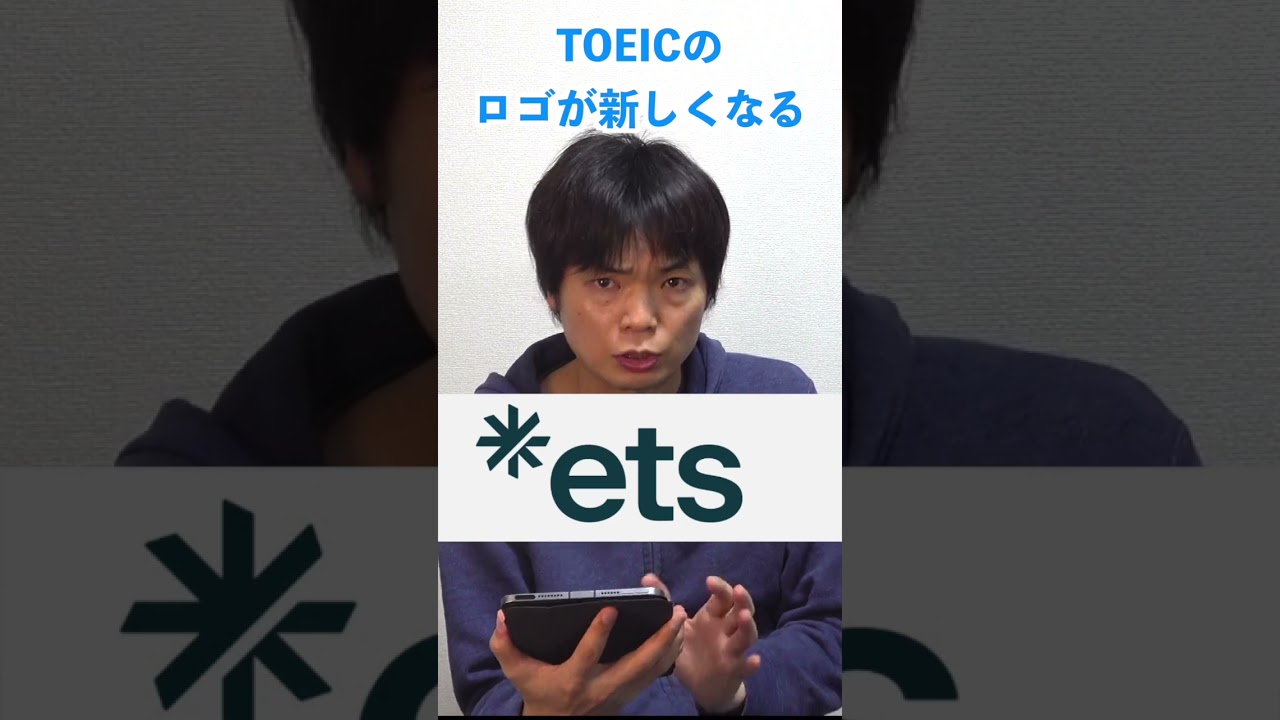
単元:
#英語(中学生)#英語(高校生)#中1英語#中2英語#中3英語
指導講師:
Morite2 English Channel
問題文全文(内容文):
TOEICのロゴが新しくなる?!
この動画を見る
TOEICのロゴが新しくなる?!
英語のjuiceはジュースじゃない #shorts

so as toの構文は使わないしenough toとも違う #shorts

単元:
#英語(中学生)#中3英語#不定詞(疑問詞+to,It~for to,ask(tell,want)O to,too~to,enough~to,not to)
指導講師:
Morite2 English Channel
問題文全文(内容文):
ネイティブに「so...as to do」の使い方が適切か聞いていきます。
以下の英文を見てみましょう!
Would you be so kind as to forward my letters?
この動画を見る
ネイティブに「so...as to do」の使い方が適切か聞いていきます。
以下の英文を見てみましょう!
Would you be so kind as to forward my letters?
日本で習うhad betterは変 #shorts

単元:
#英語(中学生)#中3英語#未来の文・助動詞(will,be going to,can,could,may,might,must,have to,should,shall,would,had better,used to,ought to)
指導講師:
Morite2 English Channel
問題文全文(内容文):
ネイティブに「had better」の使い方を聞いていきます。
使い方を知って、勉強に役立てましょう!
この動画を見る
ネイティブに「had better」の使い方を聞いていきます。
使い方を知って、勉強に役立てましょう!
1分間英文法第6講【所有格】 #shorts
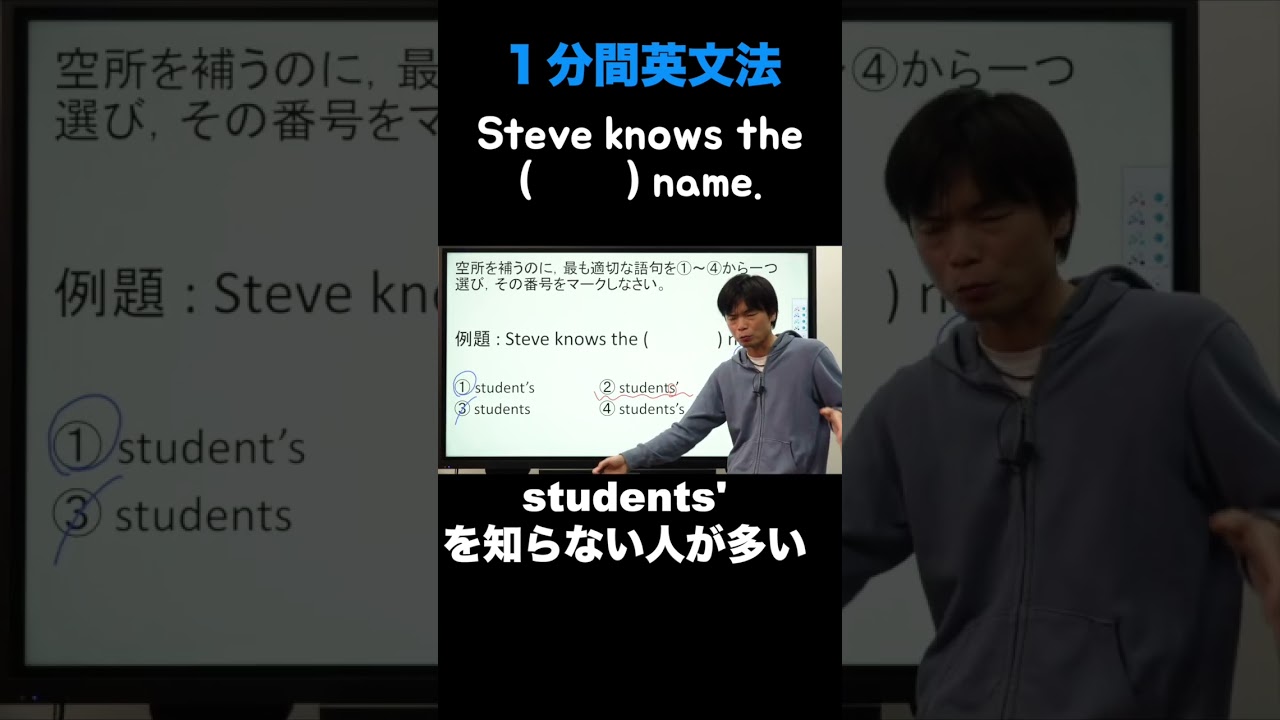
単元:
#英語(中学生)#中3英語#関係代名詞(主格、目的格、所有格、thatの用法、前置詞+関係代名詞)
指導講師:
Morite2 English Channel
問題文全文(内容文):
森田先生が所有格を解説します。
以下の問題に挑戦しましょう!
Steve knows the ( ) name.
① student's
② students'
③ students
④ students's
この動画を見る
森田先生が所有格を解説します。
以下の問題に挑戦しましょう!
Steve knows the ( ) name.
① student's
② students'
③ students
④ students's
Lesson7-4 NT Stage2 3rd Edition【ダスカロイがていねいに解説】
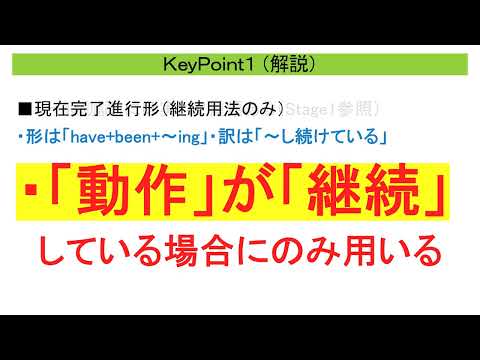
単元:
#英語(中学生)#中3英語#現在完了(継続、経験、完了・結果)
教材:
#NT ENGLISH SERIES#Third Edition Stage2#Lesson7#中高教材
指導講師:
理数個別チャンネル
問題文全文(内容文):
N.T. Third Edition Stage2 Lesson7-4のKeyPoint例文解説です。
【使用例文】
① I have been making a poster for the school festival since this morning.
② Ken has been surfing the Internet for an hour.
③ Have you been studying during the break? -Yes, I have. / No, I haven't.
④ How long have you been waiting for your teacher? - For about forty minutes.
この動画を見る
N.T. Third Edition Stage2 Lesson7-4のKeyPoint例文解説です。
【使用例文】
① I have been making a poster for the school festival since this morning.
② Ken has been surfing the Internet for an hour.
③ Have you been studying during the break? -Yes, I have. / No, I haven't.
④ How long have you been waiting for your teacher? - For about forty minutes.
【英語】Lesson7-4 Stage2 【ダスカロイがていねいに解説】
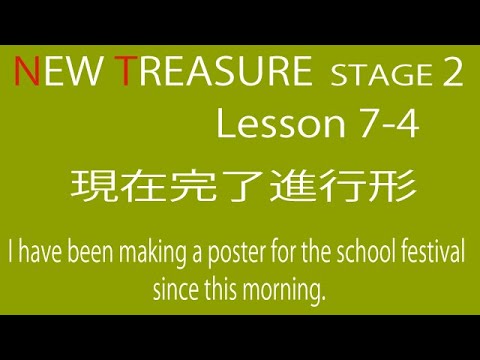
【英語】Lesson7-3 【ダスカロイがていねいに解説】
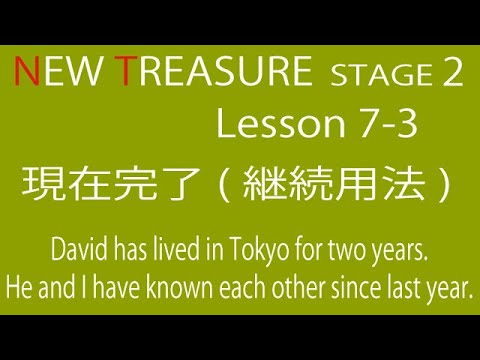
Lesson7-3 NT Stage2 3rd Edition【ダスカロイがていねいに解説】
単元:
#英語(中学生)#中3英語#現在完了(継続、経験、完了・結果)
教材:
#NT ENGLISH SERIES#Third Edition Stage2#Lesson7#中高教材
指導講師:
理数個別チャンネル
問題文全文(内容文):
N.T. Third Edition Stage2 Lesson7-3のKeyPoint例文解説です。
【使用例文】
① David has lived in Tokyo for two years.
② He and I have known each other since last year.
③ We have been in the same class for six months.
④ David hasn't seen his friends in the US for a long time.
⑤ Have you been busy since you came to Tokyo? -Yes, I have. / No, I haven't.
⑥ How long have you lived in this city? - (I have lived here) For two years.
⑦ How long has David been famous in Japan? - (He has been famous) Since he won the dance competition.
この動画を見る
N.T. Third Edition Stage2 Lesson7-3のKeyPoint例文解説です。
【使用例文】
① David has lived in Tokyo for two years.
② He and I have known each other since last year.
③ We have been in the same class for six months.
④ David hasn't seen his friends in the US for a long time.
⑤ Have you been busy since you came to Tokyo? -Yes, I have. / No, I haven't.
⑥ How long have you lived in this city? - (I have lived here) For two years.
⑦ How long has David been famous in Japan? - (He has been famous) Since he won the dance competition.
